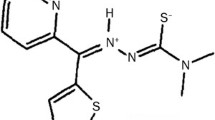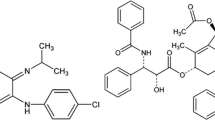Abstract
Purpose
To describe the preclinical basis for further development of 17-dimethyl aminoethylamino-17-demethoxygeldanamycin hydrochloride (17-DMAG, NSC 707545).
Methods
In vitro proliferation assays, and in vivo model studies in metastatic pancreatic carcinoma and subcutaneous xenograft melanoma and small-cell lung carcinoma models.
Results
17-DMAG emerged from screening studies as a potent geldanamycin analog, with the average concentration inhibiting the growth of the NCI anticancer cell line drug screen by 50% being 0.053 μM. “Head to head” comparison with 17-allylamino-17-demethoxygeldanamycin (17-AAG, NSC 330507) revealed 17-DMAG to possess potent activity against certain cell types, e.g., MDA-MB-231 breast carcinoma and HL60-TB leukemia which were relatively insensitive to 17-AAG. Evidence of oral bioavailability of 17-DMAG in a saline-based formulation prompted more detailed examination of its antitumor efficacy in vivo. 17-DMAG inhibited the growth of the AsPC-1 pancreatic carcinoma xenografts growing as intrahepatic metastases at doses of 6.7–10 mg/kg twice daily for 5 days administered orally under conditions where 17-AAG was without activity. 17-DMAG in an aqueous vehicle at 7.5–15 mg/kg per day for 3 days on days 1–3, 8–10 and 13–17, or 1–5 and 8–12 showed evidence of antitumor activity by the parenteral and oral routes in the MEXF 276 and MEXF 989 melanomas and by the parenteral route in the LXFA 629 and LXFS 650 adenocarcinoma and small-cell carcinoma models. The latter activity was comparable to the historical activity of 17-AAG.
Conclusions
Taken together, the in vivo activity of 17-DMAG supports the further development of this water-soluble and potentially orally administrable geldanamycin congener.






Similar content being viewed by others
Abbreviations
- AAALAC:
-
Association for the Assessment and Accreditation of Laboratory Animal Care
- 17-AAG:
-
17-Allylamino-17-demethoxygeldanamycin
- 17-DMAG-HCl:
-
17-Dimethylaminoethylamino-17-demethoxygeldanamaycin hydrochloride
- GA:
-
Geldanamycin
- GI50:
-
Concentration of drug causing 50% growth inhibition
- Hsp90:
-
Heat shock protein-90
- IP:
-
Intraperitoneal
- IV:
-
Intravenous
- LC50:
-
Concentration of drug causing 50% cell kill
- SC:
-
Subcutaneous
- T/C:
-
Treated/control tumor weight
- % T/C:
-
growth delay
- TGI:
-
Concentration of drug causing total growth inhibition
- USPHS:
-
United States Public Health Service
References
Alley MC, Scudiero DA, Monks A, Hursey ML, Czerwinski MJ, Fine DL, Shoemaker RH, Mayo JG, Boyd MR (1988) Feasibility of drug screening with panels of human tumor lines using a microculture tetrazolium assay. Cancer Res 48:589–601
Alley MC, Pacula-Cox CM, Hollingshead, MG, Camalier RF, Mayo JG, Plowman, J, Malspeis L (1995) Utility of a PVDF filter plate assay to facilitate selection of tumor cell lines for in vivo drug testing. Proc Am Assoc Cancer Res 36:305
Banerji U, Clarke P, Walton M, O‘Donnell A, Raynaud F, Turner A, Judson I, Workman P (2003) Preclinical and clinical activity of the molecular chaperone inhibitor 17-allylamino-17-demethoxygeldanamycin (17AAG) in malignant melanoma (2nd edn) (abstract 2966). Proc Am Assoc Cancer Res 44:587
Beliakoff J, Bagatell R, Paine-Murrieta G, Taylor CW, Lykkesfeldt AE, Whitesell L (2003) Hormone-refractory breast cancer remains sensitive to the antitumor activity of heat shock protein 90 inhibitors. Clin Cancer Res 9:4961–4971
Bonvini P, Gastaldi T, Falini B, Rosolen A (2002) Nucleophosmin-anaplastic lymphoma kinase (NPM-ALK), a novel Hsp90-client tyrosine kinase: down-regulation of NPM-ALK expression and tyrosine phosphorylation in ALK(+) CD30(+) lymphoma cells by the Hsp90 antagonist 17-allylamino,17-demethoxygeldanamycin. Cancer Res 62:1559–1566
Burger (2001) Pre-clinical evaluation of a methotrexate-albumin conjugate (MTX-HSA) in human tumor xenografts in vivo. Int J Cancer 92:718–724
Burger AM, Fiebig HH, Stinson SF, Sausville EA (2004) 17-Allyl-amino-17-demethoxygeldanamycin activity in human melanoma models. Anticancer Drugs 15:377–387
DeBoer C, Meulman PA, Wnuk RJ, Peterson DH (1970) Geldanamycin, a new antibiotic. J Antibiot (Tokyo) 23:442–447
Egorin MJ, Rosen DM, Wolff JH, Callery PS, Musser SM, Eiseman JL (1998) Metabolism of 17-(allylamino)-17-demethoxygeldanamycin (NSC 330507) by murine and human hepatic preparations. Cancer Res 58:2385–2396
Egorin MJ, Lagattuta TF, Hamburger DR, Covey JM, White KD, Musser SM, Eiseman JL (2002) Pharmacokinetics, tissue distribution, and metabolism of 17-(dimethylaminoethylamino)-17-demethoxy geldanamycin (NSC 707545) in CD2F1 mice and Fisher 344 rats. Cancer Chemother Pharmacol 49:7–19
Fiebig HH, Burger AM (2001) Human tumor xenografts and explants. In: Teicher BA (ed) Animal models in cancer research. Humana Press, Totowa, pp 113–137
Glaze ER, Lambert AL, Page J, Egorin M, Eiseman J, Holleran J, Tomaszewski JE (2003) Toxicity studies with 17-(dimethylaminoethylamino)-17-demethoxygeldanamycin (17DMAG; NSC 707545). Clin Cancer Res [Suppl] 9:6215s
Hollingshead MG, Alley MC, Camalier RF, Abbott BJ, Mayo JG, Malspeis L, Grever MR (1995) In vivo cultivation of tumor cells in hollow fibers. Life Sci 57:131–141
Hollingshead M, Plowman J, Alley M, Mayo J, Sausville E (1999) The hollow fiber assay. In: Fiebig HH, Burger AM (eds) Contributions to oncology, vol 54. Relevance of tumor models for anticancer drug development. Karger, Basel, pp 109–120
Jez JM, Chen JC, Rastelli G, Stroud RM, Santi DV (2003) Crystal structure and molecular modeling of 17-DMAG in complex with human Hsp90. Chem Biol 10:361–368
Johnson JI, Decker S, Zaharevitz D, Rubinstein LV, Venditti JM, Schepartz S, Kalyandrug S, Christian M, Arbuck S, Hollingshead M, Sausville EA (2001) Relationships between drug activity in NCI preclinical in vitro and in vivo models and early clinical trials. Br J Cancer 84:1424–1431
Kamal A, Thao L, Sensintaffar J, Zhang L, Boehm MF, Fritz LC, Burrows FJ (2003) A high-affinity conformation of Hsp90 confers tumor selectivity on Hsp90 inhibitors. Nature 425:407–410
Monks A, Scudiero D, Skehan P, Shoemaker R, Paull K, Vistica D, Hose C, Langley J, Cronise P, Vaigro-Wolff A, Gray-Goodrich M, Campbell H, Boyd M (1991) Feasibility of a high-flux anticancer drug screen using a diverse panel of cultured human tumor cell lines. J Natl Cancer Inst 83:757–766
Paull KD, Shoemaker RH, Hodes L, Monks A, Scudiero DA, Rubinstein L, Plowman J, Boyd MR (1989) Display and analysis of patterns of differential activity of drugs against human tumor cell lines: development of mean graph and COMPARE algorithm. J Natl Cancer Inst 81:1088–1092
Nimmanapalli R, O’Bryan E, Bhalla K (2001) Geldanamycin and its analogue 17-allylamino-1-demethoxygeldanamycin lowers Bcr-Abl levels and induces apoptosis and differentiation of Bcr-Abl-positive human leukemic blasts. Cancer Res 61:1799–1804
Omura S, Iwai Y, Takahashi Y, Sadakane N, Nakagawa A, Oiwa H, Hasegawa Y, Ikai T (1979) Herbimycin, a new antibiotic produced by a strain of Streptomyces. J Antibiot (Tokyo) 32:255–261
Sausville EA, Tomaszewski JE, Ivy P (2003) Clinical development of 17-allylamino,17-demethoxygeldanamycin. Curr Cancer Drug Targets 3:377–383
Schulte TW, Neckers LM (1998) The benzoquinone ansamycin 17-allylamino-17-demethoxygeldanamycin binds to HSP90 and shares important biologic activities with geldanamycin. Cancer Chemother Pharmacol 42:273–279
Smith V, Sausville EA, Camalier RF, Fiebig HH, Burger AM (2003) 17-DMA-geldanamycin is a novel water soluble orally bioavailable Hsp-90 inhibitor with potent in vitro and in vivo anti-cancer activity (2nd edn). Proc Am Assoc Cancer Res 44:153
Solit DB, Zheng FF, Drobnjak M, Munster PN, Higgins B, Verbel D, Heller G, Tong W, Cordon-Cardo C, Agus DB, Scher HI, Rosen N (2002) 17-Allylamino-17-demethoxygeldanamycin induces the degradation of androgen receptor and HER-2/neu and inhibits the growth of prostate cancer xenografts. Clin Cancer Res 8:986–993
Stancato LF, Silverstein AM, Owens-Grillo JK, Chow YH, Jove R, Pratt WB (1997) The hsp90-binding antibiotic geldanamycin decreases Raf levels and epidermal growth factor signaling without disrupting formation of signaling complexes or reducing the specific enzymatic activity of Raf kinase. J Biol Chem 272:4013–4020
Stebbins CE, Russo AA, Schneider C, Rosen N, Hartl FU, Pavletich NP (1997) Crystal structure of an Hsp90-geldanamycin complex: targeting of a protein chaperone by an antitumor agent. Cell 89:239–250
Supko JG, Hickman RL, Grever MR, Malspeis L (1995) Preclinical pharmacologic evaluation of geldanamycin as an antitumor agent. Cancer Chemother Pharmacol 36:305–315
Uehara Y, Hori M, Takeuchi T, Umezawa H (1985) Screening of agents which convert ‘transformed morphology’ of Rous sarcoma virus-infected rat kidney cells to ‘normal morphology’: identification of an active agent as herbimycin and its inhibition of intracellular src kinase. Jpn J Cancer Res 76:672–675
Uehara Y, Hori M, Takeuchi T, Umezawa H (1986) Phenotypic change from transformed to normal induced by benzoquinonoid ansamycins accompanies inactivation of p60src in rat kidney cells infected with Rous sarcoma virus. Mol Cell Biol 6:2198–2206
Webb CP, Hose CD, Koochekpour S, Jeffers M, Oskarsson M, Sausville E, Monks A, Vande Woude GF (2000) The geldanamycins are potent inhibitors of the hepatocyte growth factor/scatter factor-met-urokinase plasminogen activator-plasmin proteolytic network. Cancer Res 60:342–349
Whitesell L, Mimnaugh EG, De Costa B, Myers CE, Neckers LM (1994) Inhibition of heat shock protein HSP90-pp60v-src heteroprotein complex formation by benzoquinone ansamycins: essential role for stress proteins in oncogenic transformation. Proc Natl Acad Sci U S A 91:8324–8328
Xu L, Eiseman JL, Egorin MJ, D’Argenio DZ (2003) Physiologically-based pharmacokinetics and molecular pharmacodynamics of 17-(allylamino)-17-demethoxygeldanamycin and its active metabolite in tumor-bearing mice. J Pharmacokinet Pharmacodyn 30:185–219
Xu W, Yuan X, Jung YJ, Yang Y, Basso A, Rosen N, Chung EJ, Trepel J, Neckers L (2003) The heat shock protein 90 inhibitor geldanamycin and the ErbB inhibitor ZD1839 promote rapid PP1 phosphatase-dependent inactivation of AKT in ErbB2 overexpressing breast cancer cells. Cancer Res 63(22):7777–7784
Acknowledgements
We thank Ms. Kelly Dougherty, Ms. Carrie Bonomi, and Mrs. Cornelia Steidle for their excellent technical assistance. This work was funded by NCI contract NO1-CO 12400 and by a grant (RFP N01-CM-270/N01-CM-97017) from the National Cancer Institute, Bethesda, MD, to H.H.F. and A.M.B.
Author information
Authors and Affiliations
Corresponding author
Rights and permissions
About this article
Cite this article
Hollingshead, M., Alley, M., Burger, A.M. et al. In vivo antitumor efficacy of 17-DMAG (17-dimethylaminoethylamino-17-demethoxygeldanamycin hydrochloride), a water-soluble geldanamycin derivative. Cancer Chemother Pharmacol 56, 115–125 (2005). https://doi.org/10.1007/s00280-004-0939-2
Received:
Accepted:
Published:
Issue Date:
DOI: https://doi.org/10.1007/s00280-004-0939-2




